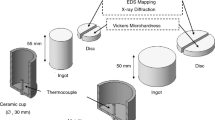Abstract
Cu–Al–Be polycrystalline SMAs modified with the addition of inoculants show improved ductility, which accredits them for technological applications. However, when the composition of these inoculants exceeds the solubility limit in the β matrix phase, precipitates occur which probably decrease the Be and/or Al content in the matrix, thus causing a change in the phase transformation temperatures. Thus, alloys that do not reach the desired phase transformation temperature need to be discarded and further processing must be performed, thereby generating additional costs in the alloy preparation process. In this sense, the main objective of this work is to investigate the influence of Cr addition on Cu–Al–Be–Nb–Ni alloys, with proportional variation of Cr and Be elements in CrBe2 ratio, alloy grain refinement and temperatures of phase transformation. Additionally, the influence of the solubility temperature of the austenite, during tempering treatment, on the phase transition temperatures of these alloys was verified. The results obtained showed that the compensation of the Be content, added in CrBe2 ratio, were efficient to maintain transformation temperatures close to the alloy without addition of Cr. It was also observed a considerable efficiency of the heat treatments in the reversion of the transition temperatures, being possible to obtain variations around 50 °C after application of the heat treatment. In this way, it is concluded that the compensation of the Be content and modifications in the solubilization temperature is efficient in the process of control of the phase transitions.









Similar content being viewed by others
References
Lagoudas DC. Shape memory alloys: modelling and engineering applications. College Station: Aerospace Engineering Department, Texas A&M University; 2008. p. 435–8.
Castillo CL, Mellor BG, Blázquez ML, Gómez C. The influence of composition and grain size on the martensitic transformation temperatures of Cu–Al–Mn shape memory alloys. Scr Metall. 1987;21:1711–6.
Kök M, Ata S, Yakıncı ZD, Aydogdu Y. Examination of phase changes in the CuAl high-temperature shape memory alloy with the addition of a third element. J Therm Anal Calorim. 2018;133:845–50.
Torra V, Martorell F, Lovey FC, Sad M. Remarks on the particular behavior in martensitic phase transition in Cu-based and Ni–Ti shape memory alloys. Shape Mem. Superelasticity. 2018;4:272–84.
Balo ŞN, Ceylan M. Effect of Be content on some characteristics of Cu–Al–Be shape memory alloys. J Mater Process Technol. 2002;124:200–8.
Baron M-P. Microstructure et comportement mecanique etmacroscopique des materiaux - genie des materiaux. Tese D. Sc., Materiaux de Lyon, France; 1998.
Prashantha S, Shashidhara SM, Mallikarjun US, Shivasiddaramaiah AG. Variation in transformation temperature and shape memory effect in Cu–Al–Be shape memory alloys with the effect of quaternary elements. Appl Mech Mater. 2015;813–814:246–51.
Candido GVM, Melo TAA, Albuquerque VHC, Gomes RM, Lima SJG, Tavares JMRS. Characterization of a CuAlBe alloy with different Cr contents. J Mater Eng Perform. 2012;21:2398–406.
Oliveira DF, Lima SJG, Brito ICA, Gomes RM, Melo TAA. Mechanical strength evaluation of a CuAlBe shape memory alloy under different thermal conditions. Mater Sci Forum. 2009;643:105–12.
Oliveira DF, Brito ICA, França FJC, Lima SJG, Melo TAA, Gomes RM. Assessment of pipe coupling by using the recovery of stress-induced martensites in superelastic Cu–11.8Al–0.6Be–0.5Nb alloy. J Mater Eng Perform. 2017;26:2264–70.
De Albuquerque VHC, Melo TAA, De Oliveira DF, Gome RM, Tavares JMR. Evaluation of grain refiners influence on the mechanical properties in a CuAlBe shape memory alloy by ultrasonic and mechanical tensile testing. Mater Des. 2010;31:3275–81.
Venkatraman M, Neumann JP. The Be–Cr (Berylliuum–Chromium) phase diagram. Bull Alloy Phase Diagr. 2018;7:15.
Lelatko J, Morawiec H. The effect of Ni, Co and Cr on the primary particle structure in Cu–Al–Nb–X shape memory alloys. Mater Chem Phys. 2003;81:472–5.
Mallik US, Sampath V. Influence of quaternary alloying additions on transformation temperatures and shape memory properties of Cu–Al–Mn shape memory alloy. J Alloys Compd. 2009;469:156–63.
Lelatko J, Morawiec H. High temperature Cu–AI–Nb- based shape memory alloys. J Phys IV France. 2011;11:487–92.
Narasimha GB, Murigendrappa SM. Influence of Gd on the microstructure, mechanical and shape memory properties of Cu–Al–Be polycrystalline shape memory alloy. Mater Sci Eng, A. 2018;737:245–52.
Adnyana DN. Effect of grain size on transformation temperatures in a grain-refined, copper-based, shape-memory alloy. Proc Metallogr. 1985;18:87–196.
La Roca PM, Isola LM, Sobrero CE, Vermaut PH, Malarría J. Grain size effect on the thermal-induced martensitic transformation in polycrystalline Cu-based shape memory alloys. Mater Today Proc. 2015;2S:S743–6.
Zare M, Ketabchi M. Effect of chromium element on transformation, mechanical and corrosion behavior of thermomechanically induced Cu–Al–Ni shape-memory alloys. J Therm Anal Calorim. 2017;127:2113–23.
Belkahla S. Elaboration et caractérisation de nouveaux alliages à mémoire de forme de basse température type CuAlBe. Villeurbanne: Institut National des sciences Appliquées de Lyon; 1990. p. 132.
Qader IN, Kök M, Dağdelen F. Effect of heat treatment on thermodynamics parameters, Crystal andmicrostructure of (Cu–Al–Ni–Hf) shape memory alloy. Physica B Condens Matter. 2019;553:1–5.
Author information
Authors and Affiliations
Corresponding author
Additional information
Publisher's Note
Springer Nature remains neutral with regard to jurisdictional claims in published maps and institutional affiliations.
Rights and permissions
About this article
Cite this article
Andrade, B.H.d., Caluête, R.E., de Oliveira, D.F. et al. Influence of the addition of Cr in the microstructure and in the phase transformation temperatures of Cu–Al–Be–Nb–Ni alloys. J Therm Anal Calorim 139, 905–911 (2020). https://doi.org/10.1007/s10973-019-08483-3
Received:
Accepted:
Published:
Issue Date:
DOI: https://doi.org/10.1007/s10973-019-08483-3




